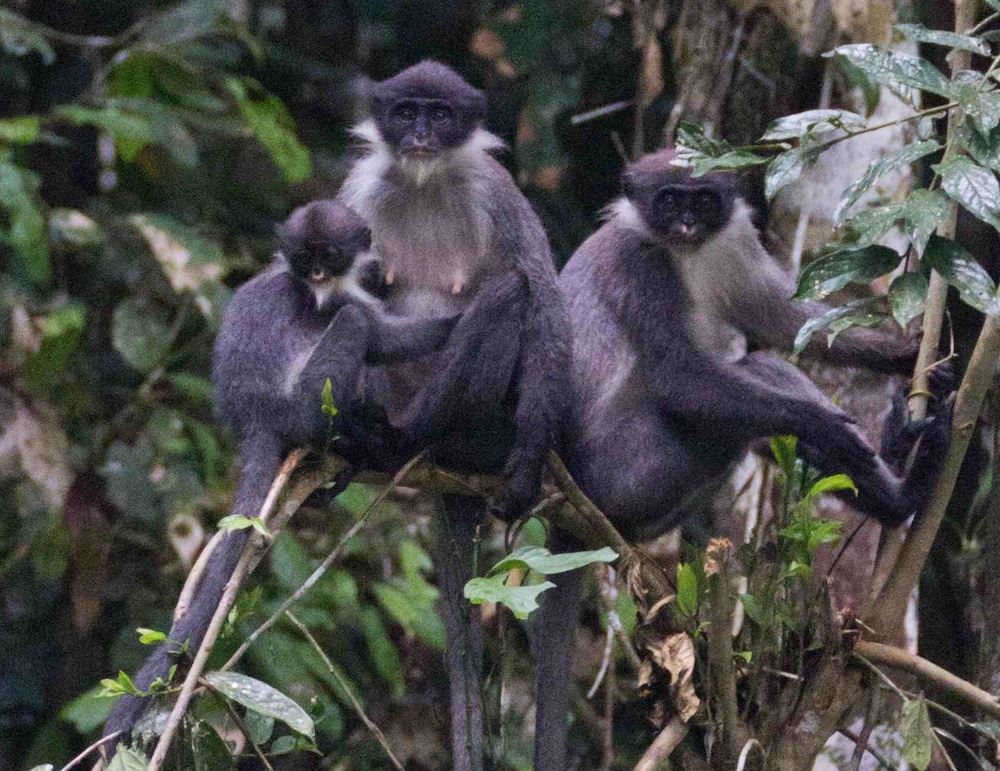
Monkey Feared Extinct Rediscovered

An elusive monkey feared extinct has shown up in the remote forests of Borneo, posing for the first good pictures of the animal ever taken.
The mug shots reveal a furry Count Dracula of sorts, with the monkey's black head, face tipped with white whiskers and a pointy collar made of fluffy white fur.
The Miller's grizzled langur, an extremely rare primate that has suffered from habitat loss over the last 30 years, popped up unexpectedly in the protected Wehea Forest in east Kalimantan, Borneo.
"We knew we had found this primate that some people had speculated was potentially extinct," said study researcher Stephanie Spehar, a primatologist at the University of Wisconsin Oshkosh. "It was really exciting."
But the animal is still in grave danger, Spehar told LiveScience, and no one knows how many of these langurs are left. The researchers observed only two small groups of them.
Vanishing act
The shy monkey (Presbytis hosei canicrus) was seen in the 1970s in Kutai National Park in Borneo, about 50 miles (80 kilometers) from where the new population lives. But as the years passed, fires and illegal logging devastated Kutai. By 2008, the Miller's grizzled langur seems to have vanished from the park. A survey that year found just five langurs living on the Sangkulirang Peninsula in East Kalitmantan, also about 50 miles (80 km) away from the newly discovered langur habitat. But by 2010, that group of primates had also disappeared.
Get the world’s most fascinating discoveries delivered straight to your inbox.
"At this point, we didn't know if this animal still existed or whether it was still hiding out in little pockets," Spehar said.
Spehar has been working in the Wehea Forest of Borneo for four years, but she'd never seen a Miller's grizzled langur there. Last summer, however, one of her undergraduate students camped out by a mineral lick area for 10 days, a spot where animals come to get nutrients from mineral-rich soil and water. The student, Eric Fell, was conducting his own research project on animals' use of these licks, and was photographing the creatures that dropped by. [Gallery: Elusive Wildlife Photos]
Upon returning from his stakeout, Fell showed Spehar his photographs. Among them were images of long-tailed, black-headed langurs.
"I knew this was something special," Spehar said. "I knew that it was something that was unexpected and we hadn't seen before."
Monkey reborn
Spehar, who credits the find to the work of local communities and governments that protect the forest and support her research, showed the photos to another researcher working in the woods, the director of the conservation organization Ethical Expeditions Brent Loken. The revelation surprised both parties: It turned out that Loken's group had also been staking out a mineral lick 5 miles (8 km) away from Fell's with a motion-triggered camera. They'd captured an image of the same type of primate. [Video of the monkeys]
"We realized that we had basically rediscovered this animal," Spehar said. Taxonomists confirmed the find as a Miller's grizzled langur. The researchers reported their find today (Jan. 20) in the American Journal of Primatology.
The simultaneous discovery suggests that there is a decent-size population of the langurs in Wehea, but Spehar cautioned that incredibly little is known about the species. No one knows how wide the langurs' range is, she said, how many there are, or their population density. That lack of knowledge isn't uncommon for many threatened species, according to Loken.
"This monkey represents a lot of species on the planet that we know very little about," Loken told LiveScience. "We don't know how many there are, we don't know where they live, what ecological requirements they need to live, and unless we get some of that information quickly, some of these species could slip into extinction before we know anything about them, or even realize that they're gone."
While Wehea itself is a more than 98,000-acre (40,000-hectare) oasis of protection, it is surrounded by forest used for logging, palm oil plantations and mining — the same sort of human uses that presumably drove the langurs out of the habitats where they once thrived. Additionally, the forest is only protected by the local community, Loken said, not the central government.
That makes the future of the Miller's grizzled langur very uncertain, Spehar said. She and her colleagues plan to conduct further research into the monkey's range and behavior to understand how best to save it from extinction. Meanwhile, Loken's group and others are working to secure extra protection for the forest.
"What we hope to do is to work with companies and concessions and with local governments to ensure this animal's protection," Spehar said. "That's the only way we will ensure that it doesn't disappear."
You can follow LiveScience senior writer Stephanie Pappas on Twitter @sipappas. Follow LiveScience for the latest in science news and discoveries on Twitter @livescience and on Facebook.

Stephanie Pappas is a contributing writer for Live Science, covering topics ranging from geoscience to archaeology to the human brain and behavior. She was previously a senior writer for Live Science but is now a freelancer based in Denver, Colorado, and regularly contributes to Scientific American and The Monitor, the monthly magazine of the American Psychological Association. Stephanie received a bachelor's degree in psychology from the University of South Carolina and a graduate certificate in science communication from the University of California, Santa Cruz.

